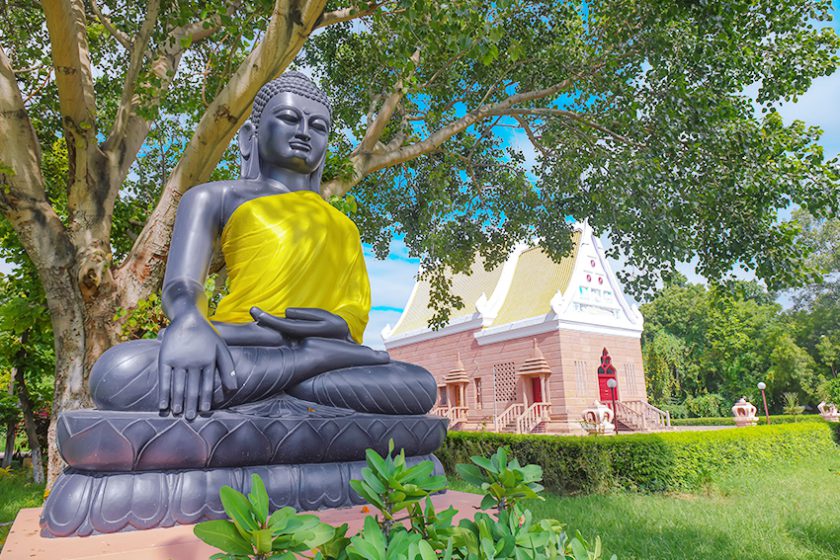Lord Buddha, the founder of Buddhism, is known for his profound teachings and is the one around whom the Buddhist Circuit revolves. The Buddhist Circuit encompasses sacred sites where the enlightened one grew up, turned the first wheel of Dhamma, abided in summer retreat, and attained Mahaparinirvana, inviting pilgrims and travellers to delve into the essence of Buddhism. Spanning across Uttar Pradesh, this circuit is a pilgrimage of the soul, offering a glimpse into the spiritual evolution of Lord Buddha and the birth of his teachings. These blessed places, adorned with temples and monasteries, hold profound significance for followers of Buddhism and seekers of inner peace.
Kapilvastu: Once the capital city of the mighty Shakya clan, Kapilavastu was where Prince Siddhārtha (later Lord Buddha) grew up as a prince and spent his first twenty-nine years before renouncing world to pursue the spiritual path leading to enlightenment. Sites like the King Suddhodhana’s palace and Piprahwa Stupa and Ganvaria, and Wat Thai Temple are a must visit and offer poignant reminders of Buddha’s early life and his spiritual journey.
Sarnath
Just 10 kilometers from the holy city of Varanasi, Sarnath is where, more than 2,500 years ago, the Buddha delivered his first sermon to a group of five ascetics after attaining enlightenment. Here, amidst the serene deer part, Buddha established his first Sangha thus his profound teachings began flourishing. The town also holds the proud symbol of India, the famous lion capital pillar or the Ashoka Pillar erected by the Emperor Ashoka. The most important sites to visit are Dhamek Stupa, marking the site where Lord Buddha gave his first sermon and Chaukhandi Stupa, Mulagandha Kuti Vihar, and Sarnath museum. Other visit-worthy sites include Vajra Vidhya Vihara, Tibetan Monastery, Wat Thai Temple, Japanese Temple, Burmese Temple, Korean Temple, etc.
Shravasti
Formerly known as the capital of the Kosala Kingdom, Shravasti clenches a close association with the life of Gautam Buddha. This place was Buddha’s favourite rainy season retreat where he spent twenty-five annual rains retreat (varsa). It is at this place that Buddha performed His first miracle known as Great Miracle. The most important sites to visit include Jetavana Vihara, Anand Bodhi tree, Angulimala Stupa, Anathapindika House and Orajhar. Other sites to visit in this sacred land are Vipassana Meditation Centre, Wat Thai Temple and Great Shravasti Centre.
Sankisa
In the village of Basantpur, Sankisa, lies the sacred site where Lord Buddha descended from the heavens, marking a pivotal moment for all Buddhist followers. The presence of an elephant pillar adds to the mystique of this spiritual destination.
Kaushambi
Kaushambi, a mere 60 kilometers from Prayagraj, bears witness to Lord Buddha’s tireless spiritual journey to spread his teachings. The remnants of ancient monasteries and fortifications serve as a testament to the flourishing Buddha’s teaching that once thrived here. The Buddhist ruins here comprise Ghositārāma Monastery, stupas and sculptures.
Kushinagar
Located in the Gorakhpur district of Uttar Pradesh, Kushinagar is en route to Kapilvastu. Journeying to Kushinagar, travellers trace the final footsteps of Lord Buddha, where he attained Mahaparinirvana. His sacred relics were divided by a brahmin named Drona into eight equal portions to be shared among eight kings who had sent envoys and armed forces to Kushinagar for that purpose. Later, the Emperor Ashoka collected the shared relics to enshrine it into more than 80,000 stupas across his kingdom and outside. It is the place where Lord Buddha gave His last sermon. This sacred site, adorned with the reclining Buddha statue and a multitude of temples, is a poignant reminder of Buddha’s ultimate liberation. Some important places to visit in Kushinagar are the reclining Buddha statue, Mahapanirvana Temple, and Mahaparinirvana Stupa. Other sites are Wat Thai Temple, Chinese Temple, Japanese Temple, etc.
Maharajganj
Maharajganj district, part of the Gorakhpur division, shares borders with Nepal’s Nawalparasi and Rupandehi Districts to the north and Bihar’s West Champaran district to the east. With rivers like Gandak, Rapti, and Rohin flowing through, it holds significant historical importance. Notably, the district is known for its Buddhist ruins, hinting at a profound connection to Gautama Buddha’s life and teachings.
Devadaha in Maharajganj district has been identified as the maternal home of Queen Mayadevi, Prajapati Gautami, and Princess Yashodhara. Queen Mayadevi passed away on the seventh day of Siddhartha’s birth. He was then brought up by his second mother, Queen Prajapati Gautami. Prince Siddhartha paid several visits to Devadaha in his childhood and spent a few years there with his stepmother. Lord Buddha took residence there and delivered the teachings contained in the Devadaha Sutta together with many other teachings on various subjects to lead beings onto the path of liberation.
Ramgram in Maharajganj district has a stupa believed to be contained Lord Buddha’s relics. The Emperor Ashoka made several efforts to remove the relics to his own capital, but had to abandon after expostulations by the local Naga king. Thus the relics in the Ramgram Stupa remained untouched. For Buddhists this Stupa is a powerful object for pilgrimage and veneration and has been so since its original construction.
Atranji Khera (Etah)
Atranji khera is located in the Etah district of Uttar Pradesh, India. It is renowned as a prominent Buddhist site, known for its archaeological treasures. Unearthed artifacts and remnants provide valuable insights into ancient Buddhist civilization, attracting researchers and historians. The site’s cultural significance lies in its preservation of Buddhist heritage, offering a glimpse into the religious and social practices of the past. Atranji khera’s historical wealth continues to captivate visitors, contributing to the broader understanding of Buddhism’s influence in the region.
The Buddhist Circuit offers more than just a physical journey; it is a passage to inner peace, enlightenment, and serenity. Amidst the chaos of modern life, embarking on this spiritual odyssey promises a profound and transformative experience.


